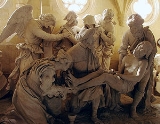
Ligier Richier
Encyclopedia


France
The French Republic , The French Republic , The French Republic , (commonly known as France , is a unitary semi-presidential republic in Western Europe with several overseas territories and islands located on other continents and in the Indian, Pacific, and Atlantic oceans. Metropolitan France...
sculptor active in Saint-Mihiel
Saint-Mihiel
Saint-Mihiel is a commune in the Meuse department in Lorraine in north-eastern France.-History:Saint-Mihiel was captured by the Germans in the first year of World War I, and was re-captured during the Battle of Saint-Mihiel from 12 September to 19 September 1918, during World War...
.
Richier primarily worked in the churches of his native Saint-Mihiel. From 1530, he was under the protection of Duke Antoine of Lorraine, for whom he did important work. Ligier Richier did work in wood, but preferred pale, soft limestone with its fine grain, and few veins, extracted at Saint Mihiel and Sorcy. He experimented with refined polishing techniques, with which he was able to give the stone a marble-like appearance. One of his finest works is the "Groupe de la Passion", consisting of 13 life-size figures made in the local stone of the Meuse region. It can be found in the Church of St. Étienne. . It is also known as the "Pâmoison de la Vierge" (the Virgin fainting, supported by St John). Other works attributed to him are in the Church of St. Pierre, Bar-le-Duc
Bar-le-Duc
Bar-le-Duc, formerly known as Bar, is a commune in the Meuse département, of which it is the préfecture . The department is in Lorraine in north-eastern France-Geography:...
, and in the Louvre
Louvre
The Musée du Louvre – in English, the Louvre Museum or simply the Louvre – is one of the world's largest museums, the most visited art museum in the world and a historic monument. A central landmark of Paris, it is located on the Right Bank of the Seine in the 1st arrondissement...
.
Possibly his most renowned work is "Le Transi de René de Chalon" in l'église Saint-Étienne of Bar-le-Duc.
Made in Sorcy stone and standing at 1m74cm, it depicts the corpse of Rene de Chalon, Prince of Orange (who died on the 15th of July 1544) in the form of a flayed corpse clutching its own heart..

